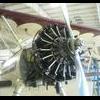Catalyst for Improving the Combustion Efficiency
of Petroleum Fuels in Diesel Engines
Walter R. May, SFA International, Inc., Houston, Texas, U.S.A.
and
Edward A. Hirs, III, FuelSpec Chemicals LLC., Houston, Texas, U.S.A.
Presented to the 11
th
Diesel Engine Emissions Reduction Conference
August 21-25, 2005, Chicago, IL
Abstract
In 1996 an oil-soluble organo-metallic iron combustion catalyst was developed for use in
Siemens-Westinghouse 501 D-5 104 MW combustion turbine engines. The product also
included oil-soluble magnesium to reduce vanadium deposits and corrosion. This
product resulted in significant reduction of smoke in the exhaust of engines operating in
steady state and non-equilibrium start-up conditions. The overall effects were greater
than predicted from the literature.
We extended this work to steam boilers and compression-ignited reciprocating engines.
We have found that the iron-magnesium catalyst when added to Diesel and heavy fuel oil
supplies, promotes complete and more efficient combustion in the engine, resulting in
increased power, improved fuel economy and radically reduced smoke emission. Certain
metals, including Mn, Fe, Cu, Ba, Ce and Pt, are known to have catalytic activity in
combustion processes. The iron-magnesium combination acts synergistically to give
greater activity than expected.
This paper presents data from tests conducted by a combustion turbine engine
manufacturer and customer, a government testing laboratory and independent fleet tests.
A mechanism for the catalysis is proposed.
Earlier papers presented on this subject are available from the SFA International web site
at www.SFAInternational.com.
1,2
Initial Application in Combustion Turbines
In 1996, Siemens Westinghouse began start-up of a new power plant at Hanwha Energy
in Inchon, Korea. There were initially three model 501 D5 104 MW combustion turbines
with nine more in process of installation. The economics of the plant were based on use
1
May, W. R. and Ramdas, R., “Catalyst for Improving the Combustion Efficiency of Diesel Fuesl”,
9
th
Annual India Oil & Gas Review Symposium, Mumbai, India, Sept. 9-10, 2002.
2
May, W. R., “Catalyst for Improving the Combustion Efficiency of Petroleum Fuels”, Technical
Exchange Meeting, Aramco Engineering Services, Research and Development Center, Dhahran,
Saudi Arabia, April 28-30, 2003.

